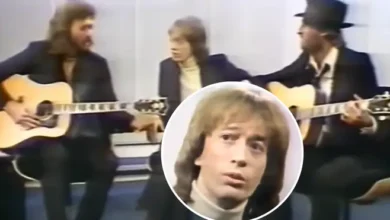Patsy Cline’s Charm Shines in “Crazy”
“Crazy” stands as a monumental piece in the history of country music, notable for its lyrical depth and emotional resonance. Written by Willie Nelson, it encapsulates the feelings of vulnerability and heartbreak that often accompany love. Although Nelson penned the song, it is Patsy Cline’s stunning interpretation that has cemented its legacy. When Cline recorded “Crazy” in 1961, it became not only a defining moment in her career but also a defining moment for the genre itself.
The lyrics of “Crazy” eloquently express the heartache of loving someone who has moved on. The narrator is trapped in a whirlwind of memories and emotions, unable to let go, which is a sentiment that resonates deeply with many listeners. This theme of unrequited love is a common thread in country music, often sung with a sincerity that touches the hearts of fans. Cline’s delivery, marked by her rich vocal timbre and emotional authenticity, injects life into the words. Each note she sings underscores the pain of longing, allowing listeners to feel as though they’re sharing an intimate moment with the artist.
Cline’s commercial success following the release of “Crazy” was significant. The song reached number 2 on the Billboard Hot Country Songs chart and solidified her position as a leading figure in the music industry during the early 1960s. Her ability to convey emotion through song made her a beloved artist, and “Crazy” remains one of her most celebrated tracks. It is often regarded as her signature song, encapsulating her artistry at a time when the genre was beginning to transform and expand its horizons. The blend of country elements with orchestral arrangements added a lushness that further highlighted the poignant message of the lyrics.
The production of “Crazy” is noteworthy as well. The orchestral backdrop, featuring strings and a gentle piano line, creates a dreamy atmosphere that enhances the overall emotional effect of the song. This combination of traditional country instrumentation with softer, melismatic lines showcases the genre’s versatility and Cline’s unique ability to blend styles. The arrangement complements Cline’s voice beautifully, allowing her to navigate the emotional depths of the lyrics while still retaining a sense of elegance. It allows the listener to feel the weight of the narrator’s despair while still appreciating the musicality of the piece.
Willie Nelson’s later rendition of “Crazy,” which he recorded for his own album, reflected his unique style, melding country with elements of jazz and blues. His version highlights his signature laid-back vocal style and intricate guitar work, demonstrating the song’s adaptability across artists and genres. This elasticity of the song reflects the strength of its composition; great songwriting can resonate beyond its original context. Both Cline’s and Nelson’s versions are celebrated for their emotional conveyance and distinct interpretations, highlighting the song’s ability to evolve while maintaining its core themes.
Following Cline’s tragic passing in a plane crash in 1963, her legacy continued to grow, and “Crazy” became a song synonymous with her memory. Many believe that had she lived longer, she would have had an even more profound impact on music. The enduring nature of “Crazy” serves as a testament to her artistry and the emotional depth of the ballad itself. In some ways, her untimely death has only amplified the song’s significance, turning it into an enduring symbol of her contributions to music. It evokes a sense of nostalgia, not just for her life but also for a simpler time in country music where heartfelt ballads dominated the charts.
In the decades since its release, “Crazy” has been covered by a wide range of artists across various genres, each bringing their own interpretation to the classic. From artists like Linda Ronstadt, who infused her version with a pop sensibility, to more contemporary renditions by singers such as Diana Krall and Chris Isaak, the song continues to attract new listeners. Each artist’s rendition contributes to the tapestry of “Crazy,” showcasing its timelessness and capacity to evoke strong emotions across different contexts and styles. These covers highlight the song’s versatility, often introducing it to audiences that may not be familiar with its origins in classic country music.
“Crazy” has also found its way into popular culture, including use in films and television shows, where its themes of heartache and longing resonate with dramatic narratives. The song has been featured in multiple movies, often accompanying scenes that underscore the pain of love lost. Such uses deepen its cultural significance, tapping into universal experiences that transcend generations. This further cements its status as a cultural artifact that transcends music and enters the realm of storytelling, inviting viewers and listeners alike to connect with their own experiences of love and loss.
Patsy Cline herself, born Virginia Patterson Hensley in 1932, had a profound impact on country music. She broke barriers as a female artist in an industry that was predominantly male and was one of the first women to gain recognition in the genre. Cline’s rich voice and ability to convey deep emotion set her apart from her contemporaries, paving the way for future female musicians. Her influence continues to be felt today, inspiring a new generation of female artists who look to her as a pioneer for women in music. Her emotional honesty and distinctive sound have made her an enduring figure in the history of American music, with “Crazy” serving as a bulwark of her legacy.
In the grand tapestry of country music, “Crazy” is not just a song, but a defining moment in the narrative of the genre, illustrating the complexities of love and the human experience. From its poignant lyrics to its rich musical composition, the song captures a depth of emotion that continues to resonate with listeners of all ages. Its lasting impact is a testament to the power of heartfelt songwriting and the ability of artists like Patsy Cline and Willie Nelson to connect with audiences through their artistry. Each performance of “Crazy” keeps the song alive, inviting new listeners to experience its beauty while honoring the legendary artists who brought it to life. In this way, “Crazy” remains an eternal testament to the human experience of love, loss, and the bittersweet memories that linger long after a relationship has ended.



